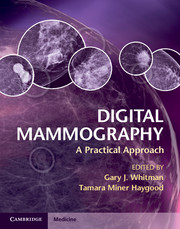Book contents
- Frontmatter
- Contents
- List of contributors
- Preface
- Acknowledgments
- Chapter 1 Detectors for digital mammography
- Chapter 2 Image acquisition
- Chapter 3 Preparing digital mammography images for interpretation
- Chapter 4 Image display and visualization in digital mammography
- Chapter 5 PACS, storage, and archiving
- Chapter 6 Interpretation of digital screening mammography
- Chapter 7 Efficacy of digital screening mammography
- Chapter 8 Artifacts in digital mammography
- Chapter 9 Mobile digital mammography
- Chapter 10 Procedures with digital mammography
- Chapter 11 Digital breast tomosynthesis
- Chapter 12 Breast computed tomography
- Chapter 13 Cases
- Chapter 14 Comparison of commercially available systems
- Index
- References
Chapter 6 - Interpretation of digital screening mammography
Published online by Cambridge University Press: 05 December 2012
- Frontmatter
- Contents
- List of contributors
- Preface
- Acknowledgments
- Chapter 1 Detectors for digital mammography
- Chapter 2 Image acquisition
- Chapter 3 Preparing digital mammography images for interpretation
- Chapter 4 Image display and visualization in digital mammography
- Chapter 5 PACS, storage, and archiving
- Chapter 6 Interpretation of digital screening mammography
- Chapter 7 Efficacy of digital screening mammography
- Chapter 8 Artifacts in digital mammography
- Chapter 9 Mobile digital mammography
- Chapter 10 Procedures with digital mammography
- Chapter 11 Digital breast tomosynthesis
- Chapter 12 Breast computed tomography
- Chapter 13 Cases
- Chapter 14 Comparison of commercially available systems
- Index
- References
Summary
Introduction
Digital and film-screen screening mammography are fairly similar in their ability to detect cancer. Depending on which paper one is reading, this might be measured by sensitivity and specificity or by comparing other measures including cancer detection rate, recall rate, and positive predictive value. Because it is not the mammogram itself that may exhibit a certain accuracy but rather the radiologist interpreting the mammogram, it follows that radiologists’ interpretation of digital screening mammograms is similar in accuracy to their interpretation of film-screen screening mammograms. There are, however, differences in the approach that may be taken. These are addressed here, and we will provide some suggestions.
Digital mammograms may be of two types, either computed radiography (CR) or digital radiography (DR). To make it more interesting, digital mammograms may be printed on film for interpretation or interpreted using soft copy on a computer monitor. Film-screen mammograms are normally interpreted on film, but they can be digitized and viewed on a computer screen, usually to serve as a comparison study to a mammogram that will be interpreted on the computer. The main focus of this chapter will be interpretation of DR-type digital mammograms on computer monitors.
- Type
- Chapter
- Information
- Digital MammographyA Practical Approach, pp. 46 - 61Publisher: Cambridge University PressPrint publication year: 2012



